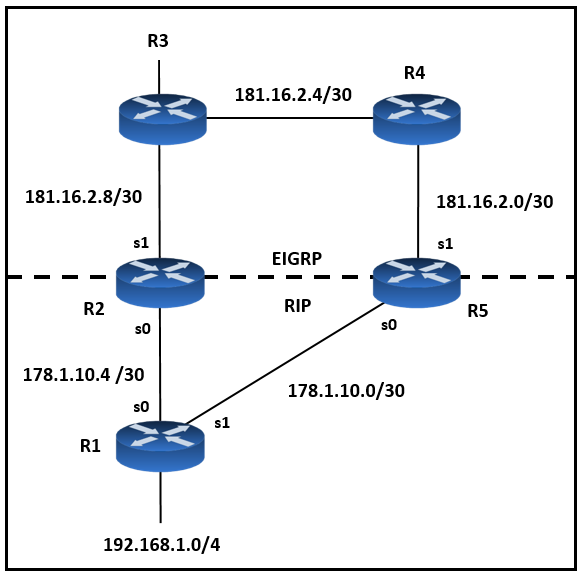
Refer to the exhibit. Mutual redistribution is enabled between RIP and EIGRP on R2 and R5. Which configuration resolves the routing loop for the 192.168.1.0/24 network?

Refer to the exhibit. Mutual redistribution is enabled between RIP and EIGRP on R2 and R5. Which configuration resolves the routing loop for the 192.168.1.0/24 network?
To resolve the routing loop for the 192.168.1.0/24 network, both R2 and R5 should block the route learned via their EIGRP interface that is connected over s0 and s1 respectively. This ensures they do not prefer the EIGRP external route with an AD of 170 over the RIP route with an AD of 120. The appropriate configuration involves using a distribute-list that filters out the 192.168.1.0/24 network on the EIGRP incoming interface. Hence, implementing a distribute-list on the correct interfaces (s0 for R2 and s1 for R5) will achieve this goal.
Example is taken from the cisco document linked by BECAUSE: https://www.cisco.com/c/en/us/support/docs/ip/enhanced-interior-gateway-routing-protocol-eigrp/8606-redist.html "[R2 and R5] are told that they must not learn network 192.168.1.0/24 through the EIGRP updates they receive on their serial 1 interface. Therefore, the only knowledge these routers have for network 192.168.1.0/24 is through RIP from R1."
R2 router igrp 7 network 172.16.0.181 redistribute rip metric 1 1 1 1 1 distribute-list 1 in s1 router rip network 172.16.0.0 redistribute igrp 7 metric 2 access-list 1 deny 192.168.1.0 access-list 1 permit any R5 router igrp 7 network 172.16.0.181 redistribute rip metric 1 1 1 1 1 distribute-list 1 in s1 router rip network 172.16.0.0 redistribute igrp 7 metric 2 access-list 1 deny 192.168.1.0 access-list 1 permit any
This question with EIGRP does not make any sense. This scenario does not create a looping. If you replace EIGRP by IGRP the looping is true, just like the exemplo in this link: https://www.cisco.com/c/en/us/support/docs/ip/enhanced-interior-gateway-routing-protocol-eigrp/8606-redist.html With IGRP instead EIGRP, D is right.
Good point! The example from the above article is for IGRP - RIP redistribution. IGRP has AD of 100 for both internal and external routes. So, R2 and R5 are going to prefer the IGRP path for 192.168.1.0/24, and not RIP with AD 120. EIGRP with external AD of 170 won't have this issue. Btw, the article has an example for EIGRP "Example 2". I think that their "Example 2" is not entirely correct.)
Some questions have a really poor quality. Based on experience, it is not better on the real exam either. :(
I'm glad I wasn't going crazy, I wrote down notes on how the route would be installed in the RIB. R2 and R5 will install the route as RIP AD 120, which will be preferred over EIGRP external AD 170, R3 and R4 will not have a cause for Loop as they will learn it through R2 and R5 respectively with AD 170. No loop here.
Given answer is correct. https://www.cisco.com/c/en/us/support/docs/ip/enhanced-interior-gateway-routing-protocol-eigrp/8606-redist.html
I agree D Both R2 and R5 are redistributing the rip route for 192.168.1.0/24. What you want to do is block that route that is being received from R3/R4 and being redistributed back into R2 and R5.
First off, the exhibit is wrong in that a loop is caused in this scenario. EIGRP has two ways of preventing this loop, 1) Split Horizon and 2) EIGRP External routes have an AD of 170. IGRP would cause a loop because AD is 100 for both internal and external routes. Life of the route 192.168.1.0/24 1) R1 advertises 192.168.1.0/24 via RIP with AD 120. 2) R2 and R5 learn the route via their links to R1 on RIP with AD 120 3) R2 and R5 redistribute the route into IGRP outbound of interface S1. 4) R3 and R4 learn the route via their links to R2 and R5 respectively and advertise it to each other, R3 to R4, and R4 to R3 5) R2 and R5 learn the route again via their links to R3 and R4, respectively. Note that this route is now learned via IGRP with an AD of 100 which is preferred over RIP AD 120. 6) Loopty doop. Solution: Filter the route from being learned via Interface S1 on R2 and R5.
For firther Clarification: Answer D according to document (router eigrp 7). However answer A is the only one where the interfaces match up to the diagram.
D is corerct